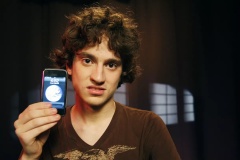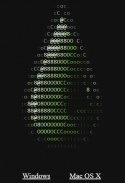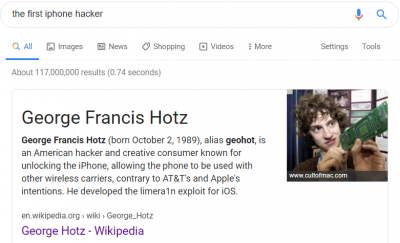George Hotz
| Birthname | George Hotz |
| Date of Birth | October 2, 1989 |
| Birth Place | Glenrock, New Jersey, USA |
| Nationality | American |
| Occupation | Hacker |
| Biography | Former hacker of the iPhone and Playstation 3. Current President of comma.ai |
George Hotz (born on October 2, 1989), also known online as geohot, is a well established hacker, primarily known for being the first person to carrier-unlock an iPhone in the Summer of 2007. Throughout his early years of hacking, he released multiple software exploits for the Apple iPhone as well as Sony's Playstation 3. These exploits released by Hotz allowed users to customize and modify their devices in ways that weren't intended by original developers. Eventually Hotz's hacking career faded away as he moved onto other projects. He is the founder and current President of comma.ai; he has also previously been employed by notable companies (including Facebook, Google, and SpaceX).
Contents
First Unlocked iPhone
In the Summer of 2007, AT&T and Apple partnered together in a program where all Apple iPhone's would be sold by AT&T; at the time, AT&T would also be the only carrier company that offered the phone. Within just a couple of months of the iPhone being released, George Hotz, a 17 year old kid from New Jersey, was able to unlock the iPhone through a hardware based method, allowing for the ability for other carriers to be used with the iPhone (such as Verizon and Sprint). When Hotz unlocked the first iPhone, it was a total bypass of AT&T and Apple's partnership program. Allowing the ability for any carrier to be used with iPhone was an incredible achievement for Hotz. In fact, it was so incredible, Hotz claimed he traded in one of his unlocked iPhone's to Terry Daidone, the cofounder of CertiCell, for Nissan 350Z and three more 8 GB iPhones.
iOS Software Exploits
A few years after carrier-unlocking iPhone's, Hotz started to create software exploits that allowed users to easily gain root access to their iPhone devices. Not only did this allow any average user to unlock their iPhone, but it also allowed for users to visually customize their device in ways uninteded (such as having a moving home-screen background).
Hotz most popular exploits include blackra1n, released in November of 2009, and limera1n, released in October of 2010.
These two iPhone exploits created by Hotz were eventually referred to as Jailbreak methods because it totally bypasses Apple's user freedom restrictions on how a user can modify their iPhone device. Apple did not initiate litigation against Hotz for his exploitation software. In fact, they deemed the action of Jailbreaking to be a legal; however, if a user chooses to modify their device, it will void that devices warranty.
After 2010, Hotz announced that he would stop partaking in creating exploits for Apple devices due to the unwanted personal attention as well as the demotivation over the technology. Nonetheless, Hotz is the one that kickstarted the iOS Jailbreaking craze, and it is continuing strong to this day. Some of the most popular future exploits would include multiple redsn0w releases, Greenpois0n, and Jailbreakme.
Sony Controversy
In December of 2009, Hotz announced his goal to breach security on Sony's Playstation 3, and within one month, he was able to successfully gain full control of the device. He released the exploit to the public in late January of 2010. This exploit allowed any average user the ability to customize their device to their liking; however, it also gave users the ability to pirate various content from Sony (such as video games). This caused a major concern for Sony, and they responded to Hotz by confronting him with litigation for the exploit he created. At the time, Hotz had no regard for Sony's litigation; he even responded with a diss rap video against Sony, egging them on to try and continue with the lawsuit. Eventually, Sony and Hotz settled in court with the promise that Hotz would not continue any hacking projects on any Sony products.
Sony Database Breach
In the Spring of 2011, Sony's personal database was breached, and over 77 million pieces of user information was stolen. Hotz was the first person that was assumed to be involved with the breach; however, it was later concluded that he was not involved. Hotz responded to the controversy, saying, "Running homebrew and exploring security on your devices is cool; hacking into someone else's server and stealing databases of user info is not cool."
Ethical Concerns With Hotz's Exploits
The exploitations created by George Hotz open many pathways for users to pirate various forms of premium content. This includes things such as: music, video games, and paid applications. Hotz's exploits themselves are not unethical; however, it is how the exploits are used that determine the ethicality. The purpose of Hotz's exploits is to give users near 'full' control of their devices, allowing users to install legal 3rd party applications that tweak their phone to their liking. An example of this would be Cydia, created by Jay Freeman. Cydia is a 3rd party App Store that was deemed legal by the U.S Copyright Office in 2010.
The Kickstarter of iPhone Hacking
It is well known among the jailbreaking community that George Hotz is the first person ever known to hack an iPhone. Without his contributions, is it possible that iPhone exploits would still even exist? Absolutely. Though Hotz is the first publicly known iPhone hacker, there are still many other people who've created exploits for the iPhone. For example, The iPhone Dev Team is a group of hackers who developed a software exploit known as redsn0w in which Hotz was not involved. In fact, redsn0w was the first iPhone software exploit ever released in the Summer of 2009; however, Hotz is still deemed as the first ever iPhone hacker due to his ability to carrier-unlock the device in 2007.
As discussed previously, Hotz's exploits (mainly for iPhone) gave users total control and freedom of their devices. In many ways, this can be seen as both good and bad.
- Good because users can customize their phones to their liking with various third party software.
- Bad because users have the new ability to steal various types of software, such as paid-for applications from the Apple App Store.
Are hackers such as Hotz to blame for giving users an unprecedented amount of device freedom and ability? The answer is no. Though Hotz popularized and help create exploits that allow users the ability to pirate content, the intention of the exploits were to allow developers to create custom software for the device that could be easily accessible by any user. The responsibility solely relies in the users hands, not in Hotz's or any other software exploit developer.
See Also
References
- comma.ai Front Page
- Apple and AT&T Partnership
- How George Hotz unlocked the original iPhone
- George Hotz trades in his unlocked iPhone
- Animated Wallpapers on an iOS Device
- blackra1n
- limera1n
- iOS Jailbreaking
- Sony Computer Entertainment America, Inc. v. Hotz
- George Hotz Diss Rap Against Sony
- Sony Security Breach
- Cydia
- US Copyright Office
- iPhone Dev Team
- redsn0w




